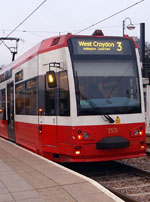British parliament criticises government
over approach to light railway schemes
By Andrew Stevens, UK Editor
12 April 2005: The excessively complicated design, build, operate and maintain contracts for light rail schemes in England has rendered such schemes unmanageable and of poor value to the public. This was among several conclusions by the British House of Commons Public Accounts Committee from an inquiry as to why so few schemes have been completed satisfactorily. "The Department for Transport has persisted in an arm's length approach towards light rail," said committee chairman Edward Leigh (Conservative).
"In general, there has been poor integration with other public transport, poor provision of supporting facilities like park and ride, and poor route planning - with lines often not connecting shopping and business areas with where people live.”, he added.
In its report, issued on 5 April 2005, the committee argued that the government’s use of such contracts had the effect that ‘operators have been left to bear all of the revenue risks, and have built risk premia into their bids’. These included parking provision at stops, traffic prioritisation, planning consent provision along the route, and other factors not under the control of operators. The report claims that this drove up the costs of the Manchester Metrolink extension, Leeds Supertram and South Hampshire Rapid Transit to the point where the Department for Transport withdrew its funding last year. It said the department had not acted quickly enough to help bidders when these problems became obvious.
The members of parliament (MPs) also criticised the lack of integration of light rail with other forms of transport. Bus operators outside London are not regulated, and so can undercut light rail with cheaper fares. The report said the DfT should require bids to show plans for transport integration. Construction costs per kilometre have ranged from £21.2m (US$38.2m) for Manchester Metrolink phase 2 to £5.4m ($9.7m) for the Sunderland extension in Tyne and Wear. The average cost was £10.2m ($18.4m).
Since 1980 the Department for Transport has contributed £1.2 billion ($2.16bn) to the £2.3 billion ($4.14bn) that has been spent on building seven light rail systems in England. Despite the cost, there has been only a partial evaluation of what light rail has delivered.
"Systems have improved the quality and choice of public transport, offering fast, frequent and reliable services and providing comfortable and safe journeys" said the report.
"But they have not delivered all of their anticipated benefits.
"Some have fallen well short of their passenger forecasts and have been poorly integrated with other forms of public transport.
"Outside London, for example, light rail and de-regulated bus services have been competing for passengers, rather than providing an integrated service."
There are seven light rail lines in England, which carried 142.9m passengers in 2003/04. These include the Metrolink in Manchester and the Supertram in Sheffield, the latter being widely held up as badly-planned and under-used by local citizens. The recent extension of the Tyne and Wear Metro from Newcastle into its neighbouring city of Sunderland was one of the more cost-effective projects.
Following the 1986 abolition of the Metropolitan Counties covering the largest cities of England, Passenger Transport Executives have been responsible for the building and upkeep of light rail systems. The number of light rail systems in England’s cities is comparatively small compared to continental Europe due to its local government system not allowing cities the ability to borrow or take risks on such schemes. Furthermore, the dependence on the car economy by central governments from the 1960s onwards saw most English cities’ tram systems torn out of the streets, with only the antiquated electric tram system in Blackpool remaining.





























